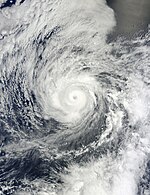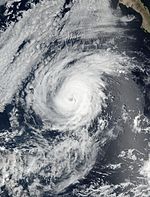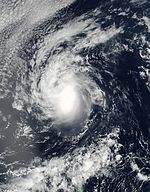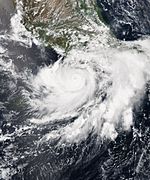User:Jarda2020/2021 Pacific hurricane season
| 2021 Pacific hurricane season | |
|---|---|
 Season summary map | |
| Seasonal boundaries | |
| First system formed | May 21, 2021 |
| Last system dissipated | Season ongoing |
| Strongest storm | |
| Name | Guillermo |
| • Maximum winds | 145 mph (230 km/h) (1-minute sustained) |
| • Lowest pressure | 930 mbar (hPa; 27.46 inHg) |
| Seasonal statistics | |
| Total depressions | 7 |
| Total storms | 7 |
| Hurricanes | 4 |
| Major hurricanes (Cat. 3+) | 3 |
| Total fatalities | 4 |
| Total damage | > $1.04 million (2021 USD) |
| Related articles | |
The 2021 Pacific hurricane season is an ongoing event of the annual tropical cyclone season in the northern hemisphere. The season officially began on May 15 in the Eastern Pacific Ocean, and will begin on June 1 in the Central Pacific; both will end on November 30. These dates historically describe the period each year when most tropical cyclones form in the Pacific Ocean basin and are adopted by convention. However, the formation of tropical cyclones is possible at any time of the year.
There has been above average activity in the eastern Pacific so far this season, with five named storms, three hurricanes, and two major hurricanes forming. The first named storm of the season, Hurricane Andres, formed on May 21, and was one of only few major hurricanes that formed in the month of May in the Eastern Pacific basin. Later on Hurricane Blanca formed on May 27, and rapidly intensified to a mid-Category 4 hurricane, while it stayed well-out to sea. Two weeks later Hurricane Carlos formed and countinued the hurricane streak. That streak was broken by Tropical Storm Dolores, that was forecasted to become a hurricane, but due to high wind shear, it only intensified into a mid-tropical storm.
Seasonal forecasts
[edit]| Record | Named
storms |
Hurricanes | Major
hurricanes |
Ref | |
|---|---|---|---|---|---|
| Average (1991–2020): | 15 | 8 | 4 | ||
| Record high activity: | 1992: 27 | 2015: 16 | 2015: 11 | ||
| Record low activity: | 2010: 8 | 2010: 3 | 2003: 0 | ||
| Date | Source | Named
storms |
Hurricanes | Major
hurricanes |
Ref |
| May 18, 2021 | SMN | 16–21 | 8–11 | 3–6 | |
| May 26, 2021 | NOAA | 12–19 | 6–10 | 1–4 | |
| Area | Named
storms |
Hurricanes | Major
hurricanes |
Ref | |
| Actual activity: | EPAC | 7 | 5 | 3 | |
| Actual activity: | CPAC | 0 | 0 | 0 | |
| Actual activity: | 7 | 5 | 3 | ||
Forecasts include weekly and monthly changes in important factors that help determine the number of tropical storms, hurricanes, and major hurricanes within a particular year. According to the National Oceanic and Atmospheric Administration (NOAA), the average hurricane season in the Eastern and Central Pacific between 1991 and 2020 contained approximately 15 tropical storms, 8 hurricanes, and 4 major hurricanes. The NOAA generally classifies a season as above average, average, or below average based on the cumulative ACE index, but occasionally the number of tropical storms, hurricanes, and major hurricanes within a hurricane season is also considered. Factors they expected to reduce activity were near- or below-average sea surface temperatures across the eastern Pacific and the El Niño–Southern Oscillation remaining in the neutral phase, with the possibility of a La Niña developing, corresponding to a low chance of an El Niño.
Seasonal summary
[edit]
Systems
[edit]Hurricane Andres
[edit]| Category 4 hurricane (SSHWS) | |
| Duration | May 21 – May 28 |
|---|---|
| Peak intensity | 130 mph (215 km/h) (1-min); 934 mbar (hPa) |
On May 16, the National Hurricane Center (NHC) began monitoring the potential for tropical cyclogenesis well south of Mexico over the following days. A broad low-pressure area formed three days later, steadily organizing to become Tropical Depression One-E at 06:00 UTC on May 21. With an increase in spiral banding and an expanding central dense overcast, the depression was upgraded to Tropical Storm Andres six hours later. Directed west-northwest and eventually northwest by a subtropical ridge over Mexico, the cyclone quickly organized and became a hurricane on May 22. A spurt of intensification saw Andres strengthen into a strong Category 2 hurricane late the next day. Andres's intensification trend leveled off thereafter due to an eyewall replacement cycle and a brief increase in vertical wind shear, but Andres still managed to reach major hurricane status early on May 24, becoming one of only six major hurricanes during the month of May. Although forecasts did not indicate additional strengthening, Andres began a period of rapid deepening the following day as wind shear decreased, intensifying into a Category 4 hurricane at 00:00 UTC on May 25. Andres reached its peak intensity six hours later with maximum sustained winds of 115 mph (185 km/h) and a minimum pressure of 934 mbar (hPa; 27.58 inHg). Thereafter, the system moved west-northwestwards over cooler waters and into a more stable environment, which led to a swift weakening trend. Andres fell below hurricane strength on the morning of May 26, and weakened into a tropical storm a day later. Further weakening ensued as convection around Andres's center dissipated, and the NHC declared Andres a remnant low on May 28.
Moisture extending from the remnants of Andres brought light rain to parts of the Southwest United States, with Phoenix, Arizona having measurable precipitation on May 29 for the first time since records began in 1896. This moisture further extended into Colorado, resulting in scattered severe thunderstorms.
Hurricane Blanca
[edit]| Category 4 hurricane (SSHWS) | |
| Duration | May 27 – June 2 |
|---|---|
| Peak intensity | 140 mph (220 km/h) (1-min); 932 mbar (hPa) |
A tropical wave that emerged off the west coast of Africa on May 12 entered the Eastern Pacific on May 25. The system organized and was classified as a tropical depression on May 27 well south of Mexico. Environmental conditions, including high sea surface temperatures and low wind shear, were highly conducive to intensification and the storm quickly organized, becoming Tropical Storm Blanca early on May 29. A small central dense overcast developed atop the storm and Blanca reached hurricane status early on May 29 after the consolidation of an eye. The hurricane achieved its peak as a Category 4 hurricane with winds of 140 mph (225 km/h) and a pressure of 932 mbar (hPa; 27.52 inHg) early on May 30. Thereafter, increasing shear degraded the hurricane's structure and weakening ensued. Rapid weakening took place on May 31 and Blanca's circulation became devoid of convection as it diminished to a tropical storm that evening. The cyclone degenerated into a remnant low soon thereafter and ultimately dissipated just off the coast of Sinaloa, Mexico, on June 2.
As the precursor to Blanca traversed Central America, it produced unseasonably heavy rainfall that triggered flooding and landslides. Four people died in various incidents related to the system: three in El Salvador and one in Honduras. Initially expecting a landfalling storm, officials in Northwestern Mexico prepared equipment for power outages, closed schools, and evacuated 180 residents. Blanca's effects largely consisted of light to moderate rainfall; some traffic accidents and landslides resulted from this, though the overall impacts were limited.
Hurricane Carlos
[edit]| Category 2 hurricane (SSHWS) | |
| Duration | June 10 – June 16 |
|---|---|
| Peak intensity | 110 mph (175 km/h) (1-min); 967 mbar (hPa) |
On June 4, a tropical wave that had traversed the Atlantic basin moved into the Eastern Pacific. Passing south of the Gulf of Tehuantepec, the disturbance gradually organized, and by June 9, satellite images showed that a surface circulation has formed, however, thunderstorm activity was too disorganized to be classified as a tropical cyclone. It is estimated that Tropical Depression Three-E formed at 00:00 UTC on June 10 about 700 miles (1,100 km) south-southwest of the southern tip of Baja California, after curved banding features developed near the center. The center became embedded in a central dense overcast, and six hours later, it was upgraded to Tropical Storm Carlos. Moving north-northwest around a ridge of high pressure, Orlene entered an area of warm sea surface temperatures and low wind shear, prompting a period of rapid intensification as a well-defined eye became visible at the center, and Carlos became a hurricane at 06:00 UTC June 11. The hurricane eventually reached its peak intensity as a high-end Category 2 hurricane with winds of 110 mph (180 km/h) at 18:00 UTC that day. The storm then moved into an area of cooler waters, which caused Carlos to weaken back to a tropical storm as it slowed down due to a trough approaching it and eventually replaced with a ridge. It began to turn west, and re-strengthened to a hurricane again before eventually succumbing to increasing wind shear and weakening again commenced. Carlos deteriorated into a remnant low by June 16, which persisted for another 12 hours before dissipating. Trailing deep tropical moisture from the remnants of Carlos passing north of the island chain produced moderate to heavy rainfall and minor flooding along the windward slopes of Haleakalā on September 23.
Tropical Storm Dolores
[edit]| Tropical storm (SSHWS) | |
| Duration | June 15 – June 20 |
|---|---|
| Peak intensity | 50 mph (85 km/h) (1-min); 1002 mbar (hPa) |
On June 12, the National Hurricane Center began to monitor an area for possible formation. On June 14, organization unexpectedly increased. Seven hours later, early on June 15, the tropical disturbance strengthened into Tropical Depression Four-E. The system quickly organized, and later that day, the NHC upgraded Four-E into Tropical Storm Dolores. Dolores slightly strengthened to peak intensity on June 17. Winds topped off at 50 mph. Soon after, Dolores weakened slightly, with winds lowering to 40 mph later that day. The storm continued westwards over the next two days. Early on June 20, Dolores became post-tropical.
Hurricane Enrique
[edit]| Category 1 hurricane (SSHWS) | |
| Duration | June 26 – July 3 |
|---|---|
| Peak intensity | 90 mph (150 km/h) (1-min); 978 mbar (hPa) |
In late June, a Kelvin wave interacted with a few tropical waves to the south of Mexico. The system gradually organized and was designated as a tropical depression on June 26, while situated about 290 mi (470 km) south-southeast of Puerto Escondido, Oaxaca. Drifting slowly northwestward, the depression was upgraded further to tropical storm intensity. Although persistent wind shear and dry air hampered intensification early on, Enrique strengthened into a hurricane on June 29 after moving into more favorable conditions. However, the return of dry air and upwelling caused the storm to deteriorate into a tropical storm. Paralleling the Mexican coast, Enrique regained hurricane intensity on July 1 and peaked with sustained winds of 90 mph (145 km/h) and a pressure of 978 mbar (hPa; 28.88 inHg) the next day. Wind shear and dry air afterwards caused Enrique to rapidly weaken, falling to tropical storm intensity on July 3 and degenerating into a remnant low-pressure area hours later. Enrique's formation prompted coastal authorities to enact precautionary measures along states deemed at risk. In Guerrero, 507 shelters were opened. The NHC also issued several tropical cyclone warnings and watches between June 27 and July 3 from Jalisco to Guerrero. Rough seas along the shore generated by the hurricane caused widespread damage. Twelve ships, including a yacht worth 11 million pesos (US$717,000), sunk in Playa Manzanillo harbor. The waves, along with heavy rain, inflicted at least 5 million pesos (US$326,000) of damage on Michoacán's coastal installations. Strong winds produced by the passing storm also downed trees, power poles, and billboards, especially in Acapulco. There, 16 homes were swept away by the waves.
Tropical Storm Felicia
[edit]| Tropical storm (SSHWS) | |
| Duration | July 9 – July 13 |
|---|---|
| Peak intensity | 60 mph (95 km/h) (1-min); 998 mbar (hPa) |
On July 7, the NHC noted that an area of low pressure was forecast to form well south of Mexico. A large mass of convection developed south of Acapulco, Mexico two days later, eventually coalescing into yet another tropical cyclone of this season. The depression intensified into Tropical Storm Felicia by 09:00 UTC on July 10, and although the cyclone struggled with westerly wind shear and upwelling, it ultimately attained peak winds of 60 mph (95 km/h) a day later. Continuing on its west-northwest path, Felicia entered cooler waters and a more stable environment, and the combination of the two factors caused the cyclone to degenerate into a remnant low well west of Baja California by 21:00 UTC on July 13. The remnants of the system moved across the main Hawaiian Island group on July 17, dropping up to 2 in (51 mm) of rain over portions of Kauai, Oahu, and Maui, with minor flooding occurring on northwestern Oahu and northern sections of Maui.
Hurricane Guillermo
[edit]| Category 4 hurricane (SSHWS) | |
| Duration | July 18 – July 29 |
|---|---|
| Peak intensity | 145 mph (230 km/h) (1-min); 942 mbar (hPa) |
On July 18, a low-pressure system organized into Tropical Depression Seven-E, before strengthening into Tropical Storm Guillermo later that day. Guillermo initially moved west-northwest, posing a threat to Hawaii. On July 19, Guillermo became a hurricane while continuing its trek towards Hawaii. Over the next few days, Guillermo struggled to intensify while being impacted by moderate wind shear. As wind shear relaxed, Guillermo was able to quickly intensify to major hurricane status on July 22. At this time, the Big Island of Hawaii was placed under a tropical storm watch, as the island began feeling the effects of high surf. Guillermo continued to rapidly intensify as it turned to the northwest and away from Hawaii, attaining peak intensity at Category 4 status with winds of 145 mph (235 km/h) and a minimum central pressure of 930 mbar (hPa; 27.46 inHg) on July 24.
After peaking in intensity, Guillermo began weakening as southwesterly wind shear increased. The system weakened to tropical storm strength at midnight on July 27 well north of Hawaii, but was soon able to reattain hurricane status while passing over anomalously warm waters and experiencing a brief respite in wind shear. Continuing to track northwards over decreasing sea surface temperatures, Guillermo weakened to a tropical storm for the last time on July 28, and became post-tropical late the next day. The remnants of Guillermo continued north across the Pacific, before turning to the east-northeast towards western Canada on July 31. On August 2, the extratropical remnants of Ignacio were absorbed by a cold front, hundreds of miles south of Alaska.
Storm names
[edit]The following names will be used for named storms that form in the northeastern Pacific Ocean during 2021. Retired names, if any, will be announced by the World Meteorological Organization during the joint 44th Sessions of the RA IV Hurricane Committee in the spring of 2022. The names not retired from this list will be used again in the 2027 season. This is the same list used in the 2015 season, with the exception of the name Pamela, which replaced Patricia.
|
|
|
For storms that form in the Central Pacific Hurricane Center's area of responsibility, encompassing the area between 140 degrees west and the International Date Line, all names are used in a series of four rotating lists. The next four names that will be slated for use in 2021 are shown below.
|
|
|
|
Season effects
[edit]This is a table of all the storms and that have formed in the 2021 Pacific hurricane season. It includes their duration, names, landfall(s), denoted in parentheses, damages, and death totals. Deaths in parentheses are additional and indirect (an example of an indirect death would be a traffic accident), but were still related to that storm. Damage and deaths include totals while the storm was extratropical, a tropical wave, or a low, and all the damage figures are in 2021 USD.
| Saffir–Simpson scale | ||||||
| TD | TS | C1 | C2 | C3 | C4 | C5 |
| Storm name |
Dates active | Storm category at peak intensity |
Max 1-min wind mph (km/h) |
Min. press. (mbar) |
Areas affected | Damage (USD) |
Deaths | Ref(s) | ||
|---|---|---|---|---|---|---|---|---|---|---|
| Andres | May 21–28 | Category 4 hurricane | 130 (215) | 934 | Southwestern United States | None | None | |||
| Blanca | May 27–June 2 | Category 4 hurricane | 140 (220) | 932 | Central America, Baja California Peninsula, Northwestern Mexico | Minimal | 4 | |||
| Carlos | June 10–16 | Category 2 hurricane | 110 (175) | 967 | None | Minimal | None | |||
| Dolores | June 15–20 | Tropical storm | 50 (85) | 1002 | None | None | None | |||
| Enrique | June 26–July 3 | Category 1 hurricane | 90 (150) | 978 | Southwestern Mexico, Western Mexico | $1.04 million | 0 | |||
| Felicia | July 9–13 | Tropical storm | 60 (95) | 998 | None | None | None | |||
| Guillermo | July 18–29 | Category 4 hurricane | 145 (230) | 930 | Hawaii, Western Canada | None | None | |||
| Season aggregates | ||||||||||
| 7 systems | May 21–Season ongoing | 145 (230) | 930 | >$1.04 million | 4 | |||||
See also
[edit]- Tropical cyclones in 2021
- Pacific hurricane
- 2021 Atlantic hurricane season
- 2021 Pacific typhoon season
- 2021 North Indian Ocean cyclone season
- South-West Indian Ocean cyclone seasons: 2020–21, 2021–22
- Australian region cyclone seasons: 2020–21, 2021–22
- South Pacific cyclone seasons: 2020–21, 2021–22














